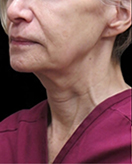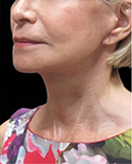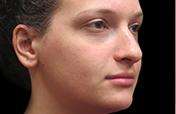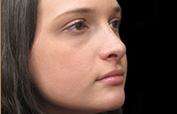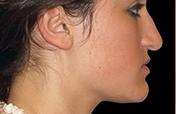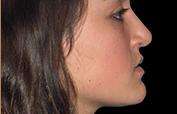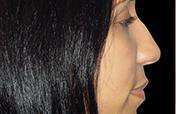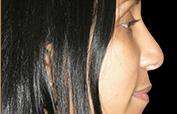Rhinoplasty
Conveniently located to serve the areas of New York, NY
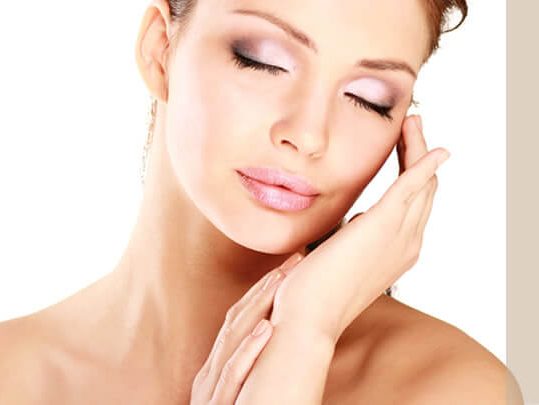
According to the American Society of Plastic Surgeons, rhinoplasty (nose surgery) is consistently among the most common cosmetic surgeries, with hundreds of thousands of Americans opting for nose surgery each year.* It’s not surprising, given that the nose is the most prominent facial feature. Even subtle changes in the nose can have a dramatic impact on not only the nose itself, but the overall aesthetics of the face. That’s why it’s so important to have a skilled and experienced rhinoplasty surgeon with expertise in facial aesthetics and a deep understanding of how all the different features of the face interrelate.
Contents
Before and After Photos
Dr. Elie Levine stresses an artistic, nuanced, and customized approach for each patient. The goal of rhinoplasty is to improve overall facial aesthetics in the most natural-looking way possible, not to create a one-size-fits-all “designer nose.” Whether you’re interested in improving the shape, size, or proportion of your nose; removing a bump; reshaping the nostrils; or changing the tip, we can help. At Plastic Surgery & Dermatology of NYC, we are keenly aware that each patient has individual goals and a unique anatomy. Our customized approach to rhinoplasty can help you achieve an attractive and, most importantly, natural-looking and beautiful nose that is well-balanced and in perfect harmony with the rest of your face.*
Procedure
- Change size of nose
- Change shape of nose
- Remove hump
- Straighten nose
- Correct bulbous or drooping tip
- Reshape nostrils
- Change the angle or upturn of nose
- Bring nose into balance with rest of face
- Correct breathing/functional problems
- Correct deviated septum
- Repair defects due to traumatic injury
- Correct asymmetry
- Correct problems from previous nose surgeries (revision rhinoplasty)
- Resize, reshape, or improve the appearance of ethnic noses
When considering rhinoplasty, it’s important to understand how all aspects of facial harmony relate. Even though you might be concerned about just one aspect of your nose, you need to consider overall facial aesthetics. While some nose surgeons concentrate on “fixing” one specific problem with a nose, Dr. Levine takes into consideration that even a small change in one area of the nose will affect its relationship to not only the rest of the nose, but also to the rest of the face. In addition to being aware of this big picture, Dr. Levine also stresses an approach that can yield natural-looking results. At Plastic Surgery & Dermatology of NYC, we take a highly customized approach to ensure that your nose looks completely natural on your face.* Finally, you should look for a rhinoplasty surgeon with the right training and experience to perform a full range of nose surgeries, from the simplest to the most complex procedures.
| RHINOPLASTY (NOSE SURGERY) AT A GLANCE | ||
| Procedure* | Recovery* | Results* |
| Performed in our accredited in-office surgical facility | Go home same day | Final results noticeable in 6-12 months |
| Surgery time approximately 2-3 hours | Back to work in 7-9 days | Results are long-lasting |
| Closed and open techniques available, depending on type of correction needed | Light cardio exercise in 5-7 days | |
| Twilight to general anesthesia, depending on extent of procedure | More strenuous exercise in 2-3 weeks | |
| Most early swelling resolves in 7-9 days, with residual swelling for some months after surgery | ||
Ideal Candidate
You may be a good candidate for rhinoplasty if you are unhappy with the appearance of your nose, you want to optimize your overall facial harmony, you have impaired breathing through your nasal passages, or you want to correct problems from a previous nose surgery. Candidates for rhinoplasty are generally in good health and have realistic expectations about results. Dr. Levine will meet with you to discuss how to achieve an attractive, natural-looking nose that is in balance with the rest of your face. At Plastic Surgery & Dermatology of NYC, we understand that having rhinoplasty is a very personal decision, and we stand ready to provide you with all the information you need to make the decision that’s best for you.
Airflow Correction
Whether you have impaired breathing due to a traumatic injury or congenital condition, rhinoplasty can help improve airways and correct many functional problems in the nose. There are two surgical procedures that can help relieve airway obstruction and chronic nasal congestion. Septoplasty is a procedure to correct a deviated septum, a condition in which the bone and cartilage that divides the nostrils becomes displaced, causing impaired breathing. Turbinate Reduction is a procedure to reduce the size of the turbinate, a nasal structure that helps to warm and humidify the air we breathe. Turbinates naturally become temporarily enlarged when we suffer from colds and allergies, but in some people, turbinates may remain persistently enlarged, causing chronic nasal congestion. Septoplasty and Turbinate Reduction are often performed together to ease airway obstruction and congestion. In addition, these procedures can also be combined with cosmetic rhinoplasty for both improved function and enhanced aesthetics. Dr. Levine will meet with you to discuss your concerns, assess your condition, and help you determine if you are a good candidate for nose surgery.
Open vs Closed Rhinoplasty
Dr. Levine is experienced in both open and closed rhinoplasty techniques. In “closed” rhinoplasty (endonasal rhinoplasty), all the incisions are made inside the nose. In “open” rhinoplasty (external rhinoplasty), most of the incisions are made inside the nose, except for one small external incision made across the skin between the nostrils at the base of the nose (the “columella”). The decision about whether to use the open or closed technique is based on many factors, including the extent of the rhinoplasty surgery and the patient’s unique anatomy. Dr. Levine will examine both the internal and external structures of your nose thoroughly, and will discuss with you the best technique to use for your nose surgery.
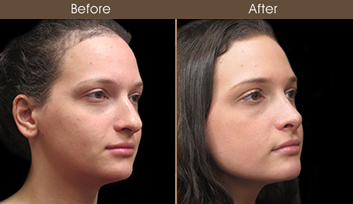
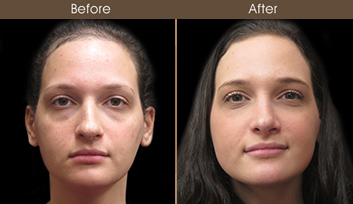
Results
Dr. Levine uses a state-of-the-art computer imaging system that can help you visualize what your nose may look like after rhinoplasty surgery. While no computer system can guarantee results, we find that this can help patients have realistic expectations for their results.
Rhinoplasty Types
Revision Rhinoplasty
Unfortunately, not every surgeon has the same level of skill and experience when it comes to nose surgery, and consequently, sometimes people come to us seeking help in revising a nose surgery that didn’t meet their expectations. Whether you are unhappy with the aesthetic results of your previous surgery, or you are experiencing complications from anatomical or functional abnormalities, we can help. Dr. Levine is experienced in all types of rhinoplasty, from the more straight-forward procedures to the most complicated rhinoplasty revisions. Call the office today to set up a personal consultation with Dr. Levine in order to determine if you are a good candidate for revision rhinoplasty.
Ethnic Rhinoplasty
Working with ethnic noses requires skill and experience, as well as an understanding of the anatomical nuances of the ethnic nose. Dr. Levine is well-versed in rhinoplasty for Asian, African American, Hispanic, and other ethnic nose types.
Young Rhinoplasty
When younger people are not happy with their appearance, it can affect their self-image and self-confidence for years to come. If your son or daughter is self-conscious about his or her nose, you should meet with Dr. Levine to find out if your teenager is a good candidate for rhinoplasty. Nose surgery can be performed after a person’s face and nose are fully developed and the individual is mature enough to understand the process they are considering.
Other Procedures
Because even subtle changes in the nose can have a dramatic impact on your overall facial appearance, rhinoplasty is sometimes combined with other facial cosmetic procedures to produce a well-balanced, natural-looking result.* During your initial consultation, Dr. Levine will assess both your nose anatomy and your entire facial structure. By understanding the relationship between the nose and the rest of the face, Dr. Levine can help you determine whether additional procedures, such as chin augmentation, might bring about the most optimal results.
Preparation
During your initial rhinoplasty consultation, Dr. Levine will examine your internal and external nose structure, as well as your entire facial aesthetics. He will thoroughly discuss your goals and expectations, including possible risks and the best way to prepare for your nose surgery. He will let you know what to expect before, during, and after your procedure, and he will answer any questions that you may have.
Anesthesia Types
The type of anesthesia used will depend on the extent of your procedure and can range from twilight sedation to general anesthesia. You will discuss your rhinoplasty surgery thoroughly with both Dr. Levine and our board-certified anesthesiologist to determine the best type of anesthesia for your needs.
Expectations
Most rhinoplasty surgery is performed on an outpatient basis in our state-of-the-art, in-office operating suite, which is accredited by the American Association for Accreditation of Ambulatory Surgery Facilities (AAAASF). For patients who need or request a hospital setting, Dr. Levine is affiliated with both The Mount Sinai Medical Center and The New York Eye and Ear Infirmary. The length of your procedure will, of course, depend on what type of nose surgery you are having, but on average, the procedure usually takes about 2-3 hours.* After your procedure, you will wake up in our warm and caring recovery suite, where our licensed, registered nurse will make sure you are comfortable and assist in your recovery. You will be able to go home the same day with a friend or family member.
Results
Every surgery is different, and you will receive detailed post-operative instructions for your specific needs. However, in general, you can expect to have a puffy nose and possible bruising and swelling around the eyes after your rhinoplasty surgery. Icing and head elevation will help to control swelling. The majority of the early swelling will resolve in about 7-9 days, with mild residual swelling for months after the surgery. Your nose may be packed and splinted after surgery. In most cases, the splint is removed in about a week. Most patients report mild to moderate pain after the surgery, which is usually well-tolerated with medications.* At Plastic Surgery & Dermatology of NYC, our concern for you doesn’t end when you go home. We’re dedicated to providing ongoing care to ensure a fast, safe, and smooth recovery. Dr. Levine will see you for post-operative visits, and he and our staff stand ready to answer any questions you may have about your recovery, as well as your overall health and well-being.
Contact
Dr. Elie Levine will be happy to meet with you to discuss post-bariatric weight loss procedures. Please call our office at (212) 988-1800, or make an appointment online for a personal consultation in our New York City offices.
